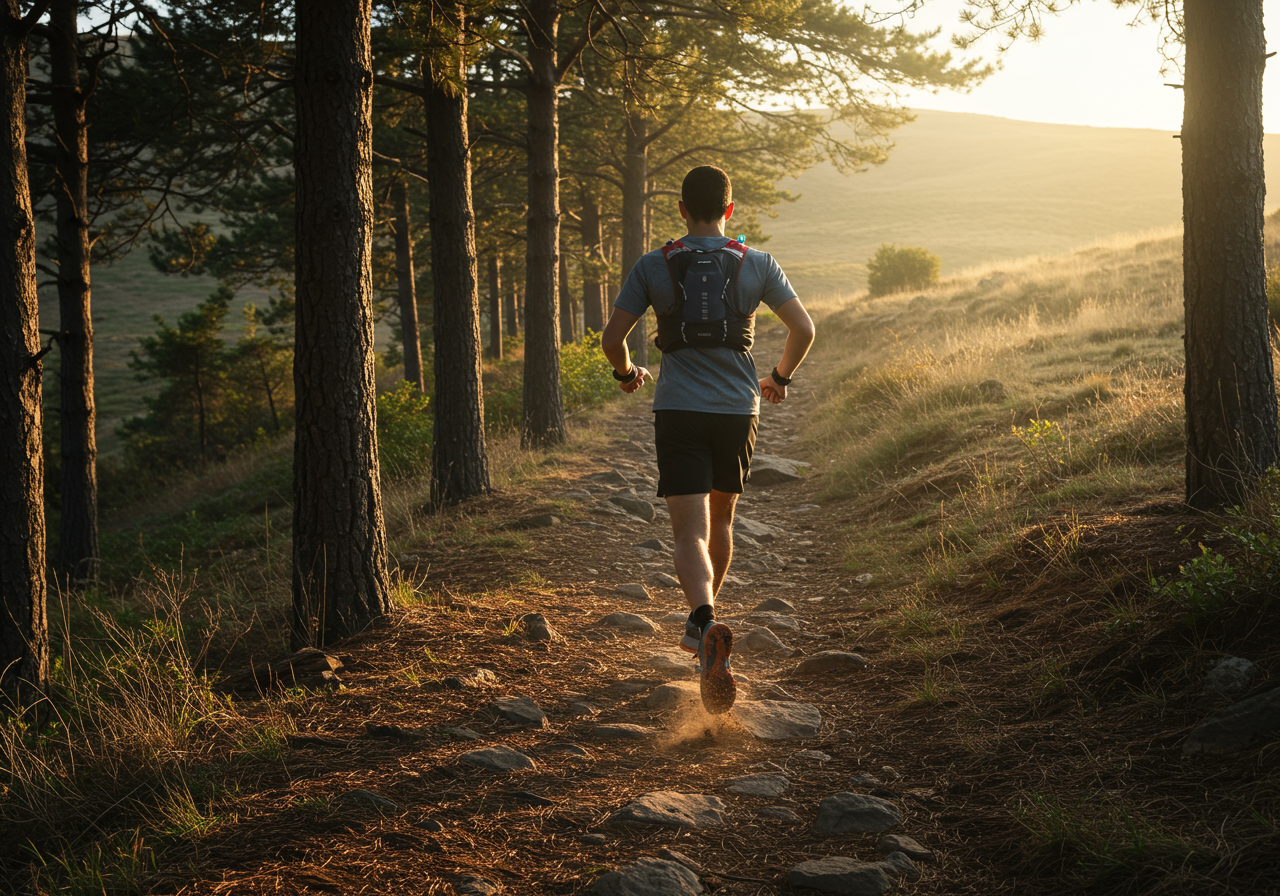Build Your Off‑Road Base: Principles, Gear, and Safe Starts

Trail running fundamentals that protect joints and build steady endurance
Trail running rewards patience and attention. I teach simple rules that keep beginners safe and improving weekly.
Soft landings, short strides, and tall posture reduce pounding. I learned this after a hurried descent strained my calf.
- Cadence first: Aim for 170–180 steps per minute on flat terrain.
- Short stride: Land under hips to protect knees and ankles.
- Eyes scan ahead: Look 2–3 steps forward for obstacles.
- Use the terrain: Power hike steep grades to control heart rate.
- Effort over pace: Trails vary; train by zones, not minutes per mile.
- 2 minutes ankle circles and calf raises.
- 3 x 20 seconds fast feet in place.
- 4 x 20 seconds downhill steps on gentle slope.
- 2 minutes brisk hike with tall posture.
| Item | Purpose | My pick |
|---|---|---|
| Trail shoes | Grip and rock protection | Moderate lugs, rock plate, 4–8 mm drop |
| Hydration vest | Carry water, gels, phone | Soft flasks, snug fit, whistle |
| Watch with HR | Zone control and tracking | Garmin wrist HR plus GPS |
| Poles (optional) | Steep climbs efficiency | Only on long, steep routes |
I record runs on Strava and review cadence and elevation.
Zone guide I use on trails:
| Zone | % Max HR | Feel |
|---|---|---|
| Z1 | 55–65% | Very easy, nose breathing |
| Z2 | 65–75% | Easy talk pace |
| Z3 | 75–85% | Steady, words in short phrases |
| Z4 | 85–92% | Hard, focused breathing |
| Z5 | 92–100% | Very hard, short bursts |
Your Weekly Structure: Beginner to Advanced Progressions

From first trail steps to confident ridgelines using clear weekly structure
Progress comes from planned stress and recovery. I scale terrain, volume, and vertical gain step by step.
Beginners focus on time-on-feet. Intermediates add climbs. Advanced runners refine intensity and technical skill.
- Volume: Add 5–10% weekly.
- Vertical gain: +50–150 m per week for beginners.
- Technicality: Move from smooth dirt to roots and rocks.
- Intensity: Introduce Z3–Z4 once base feels stable.
| Level | Weekly sessions | Focus | Typical time |
|---|---|---|---|
| Beginner | 3 runs + 1 strength | Z1–Z2, easy terrain | 60–120 min total |
| Intermediate | 4 runs + 2 strength | Hills, tempo, skills | 150–240 min total |
| Advanced | 5 runs + 2 strength | Vertical, intervals, descents | 270–420 min total |
- Week 1: 3 x 20 min Z2 trails, 50–100 m gain each.
- Week 2: 1 x 25 min, 2 x 20 min; add 2 x 30 sec brisk hikes.
- Week 3: 1 x 30 min, 2 x 20 min; include 3 short hill hikes.
- Week 4: Deload at 70% volume; keep easy terrain.
| Session | Beginner | Intermediate | Advanced |
|---|---|---|---|
| Easy run | 25–40 min Z2 | 40–60 min Z2 | 60–90 min Z1–Z2 |
| Hills | 6 x 30 sec brisk hike Z3 | 8 x 45 sec run Z3–Z4 | 10 x 60 sec Z4 |
| Long run | 45–60 min easy | 75–90 min easy | 100–150 min easy |
| Strength | 2 x 10 bodyweight moves | 3 x 8 split squats, RDLs | 3 x 6 heavier lifts |
Client Ana began with 90 minutes weekly. After 8 weeks, she handled 210 minutes comfortably.
Her vertical tolerance rose from 200 m to 800 m weekly without soreness spikes.
Energy Systems and Terrain Tactics for Speed and Control

Train by zones and landscapes to upgrade speed, power, and efficiency
Different trails train different systems. I match workouts to climbs, flats, and descents for complete conditioning.
Zone work improves your engine. Technique work improves control. Together, they raise sustainable speed.
- Aerobic base (Z1–Z2) grows capillaries and fat use.
- Tempo (Z3) raises lactate threshold on steady climbs.
- VO2 max (Z4–Z5) bumps oxygen delivery using short hills.
- Eccentric control from descents protects quads.
- 10 min Z2 warm‑up on rolling trail.
- 8 x 45 sec uphill Z4, walk down recovery.
- 6 min moderate descent focusing soft steps.
- 5 min easy cool‑down.
| Workout | Terrain | Zone | Benefit |
|---|---|---|---|
| Base cruise | Smooth singletrack | Z2 | Endurance and fat metabolism |
| Uphill tempo | Long gradual climb | Z3 | Threshold and mental focus |
| Hill sprints | Short steep hill | Z5 | Power and economy |
| Descent drills | Gentle downhill | Z2 | Eccentric tolerance and footwork |
My Tuesday workout uses 6 x 2 minutes uphill at high Z4. My watch shows 6–8% grade works best.
After 6 weeks of this, my VO2 max rose ~8% on Garmin. My Strava uphill segments improved 6–9% times.
| Drill | Reps | Cue |
|---|---|---|
| Fast feet downhill | 4 x 30 sec | Light steps, quiet landings |
| Power hike | 6 x 1 min | Drive elbows, tall chest |
| Rock garden shuffle | 5 passes | Eyes 2–3 steps ahead |
Eight Weeks to Confident Trails: Step-by-Step Onboarding

Your first eight weeks made simple and sustainable
This plan builds habits and resilience. It respects recovery while nudging fitness forward every seven days.
I designed it for true beginners. You will control effort with heart rate or breathing.
- Time based, not distance based.
- Keep most minutes in Z2.
- Use RPE 4–6 if no heart rate monitor.
- Deload every fourth week.
| Week | Runs | Long Run | Vertical | Strength/Mobility |
|---|---|---|---|---|
| 1 | 2 x 25 min Z2, 1 x 20 min Z2 | 30 min easy | 150–200 m | 2 x 15 min basics |
| 2 | 2 x 30 min Z2, 1 x hills 6 x 30 sec | 40 min easy | 250–300 m | 2 x 20 min |
| 3 | 1 x 35 min, 1 x 25 min, hills 8 x 30 sec | 50 min easy | 300–400 m | 2 x 20 min |
| 4 | Deload: reduce to 70% | 35 min easy | 200–250 m | 1–2 x 15 min |
| 5 | 2 x 35 min, hills 6 x 45 sec | 60 min easy | 350–450 m | 2 x 20 min |
| 6 | 1 x 40 min, 1 x 30 min, hills 8 x 45 sec | 70 min easy | 450–600 m | 2 x 20 min |
| 7 | 1 x 45 min, 1 x 30 min, hills 10 x 45 sec | 80 min easy | 550–700 m | 2 x 20 min |
| 8 | Deload: reduce to 70% | 60 min easy | 350–450 m | 1–2 x 15 min |
- 2 min brisk walk with arm swings.
- 2 x 30 sec skipping drills.
- 10 calf raises, 10 hip hinges, 10 lunges.
- 4 x 10 sec strides on flat.
Strength keeps ankles and knees happy. I favor split squats, Romanian deadlifts, and calf eccentrics.
| Exercise | Sets x Reps | Rest |
|---|---|---|
| Split squat | 3 x 8 each | 60–90 sec |
| RDL with dumbbells | 3 x 8 | 90 sec |
| Eccentric calf raises | 3 x 12 | 45–60 sec |
| Side plank | 3 x 30–45 sec | 45 sec |
Fueling supports progress. Beginners often underfuel trails due to slow pace illusions.
| Nutrition | Target | Notes |
|---|---|---|
| Daily calories | Bodyweight x 28–32 kcal | Adjust to body goals |
| Protein | 1.6–2.2 g/kg | Spread across meals |
| Carbs pre‑run | 30–60 g | Low fiber options |
| Electrolytes | 300–600 mg sodium/hr | Heat and sweat dependant |
I track intake on MyFitnessPal. I sleep 7.5–8.5 hours on training weeks.
Proof, Tracking, and Troubleshooting for Real Results

Evidence of progress and long-term result interpretation
Data confirms improvement. Feeling great matters, but numbers prevent guesswork and guide adjustments.
I validate results with VO2, heart rate, segments, and soreness patterns. Clients appreciate objective wins.
- Minutes in each zone.
- Total vertical gain.
- Long run completion and RPE.
- Sleep hours and morning soreness.
| Metric | Baseline | 8 weeks | 16 weeks |
|---|---|---|---|
| VO2 max (Garmin) | 44 ml/kg/min | 48 (+9%) | 50 (+14%) |
| Resting HR | 60 bpm | 55 bpm | 53 bpm |
| 5K trail time | 34:20 | 31:10 | 29:50 |
| Weekly vertical | 200 m | 700 m | 1,200 m |
Client Marco shared this after week ten: “I breathe easier on climbs and recover faster between repeats.”
Client Ana said: “I used to fear descents. Now I float down and feel stable.”
- Pick one uphill Strava segment of 2–4 minutes.
- Run it monthly in Z4 after a rest day.
- Compare heart rate and time. Log feelings.
| Problem | Likely cause | Fix |
|---|---|---|
| Plateau | No change in stimulus | Add short Z4 hills or more vertical |
| Sore quads | Too much downhill | Limit hard descents; add eccentric calves |
| Low energy | Underfueling or poor sleep | 30–60 g carbs pre‑run; 7–9 hours sleep |
| Ankle tweaks | Weak stabilizers | Add balance work and slow foot drills |
I analyze training load with Garmin Training Status and Strava Relative Effort. I adjust before fatigue accumulates.
HIIT hill sessions reduced fat faster for me than only easy runs. However, I cap them to one weekly early.
I once skipped warm‑up and paid with a strained calf. I never skip the 8‑minute primer now.






